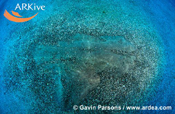Release of Red List underscores urgency for conservation action

The Shark Alliance is highlighting with concern the growing number of European sharks and rays considered at risk for extinction, according to the newly released 2007 IUCN (World Conservation Union) Red List of Threatened Species. Experts have added 18 species of sharks (and closely related skates, rays and chimaeras) to the Globally Threatened categories, bringing the overall tally to 126 -- 22% of the species evaluated. That percentage is even higher for European waters, where a full third of such species are considered Threatened.
"This year's Red List reflects a global shark crisis driven by minimally controlled fishing in the face of increasing demand for shark products. Nowhere is this crisis more apparent than in Europe," said Sonja Fordham, Policy Director for the Shark Alliance.
"European Union fishery managers have pledged to conserve sharks, but action has been grossly insufficient. In order to bring Europe's threatened sharks back from the brink and prevent further depletion, the EU urgently needs stringent limits on shark fishing as part of an overall conservation plan."
European shark and ray species added to the Threatened categories (Vulnerable, Endangered and Critically Endangered) this year include:
- Smoothback and Sawback Angel Sharks - moving from the Endangered to the Critically Endangered category. The primary threat to these flattened, bottom-dwelling sharks, found in the Western Mediterranean, is incidental take ("bycatch") in unselective fishing gear. An EU prohibition on retention of angel sharks is warranted, as are measures to minimize bycatch
- Great Hammerhead Sharks - uplisted from Data Deficient to Endangered. These key, wide-ranging predators often fall victim to finning (the wasteful practice of slicing off a shark's valuable fins and discarding the body at sea), due to their high value fins and low value meat. Hammerhead sharks would greatly benefit from a stronger EU finning ban which prohibits the removal of shark fins at sea, without exception.
- Blackchin and "Common" Guitarfish - added to the Red List as Endangered. These species are thought to be locally extinct in parts of their former Mediterranean range. The fins from guitarfish are among the world's most prized for the Asian delicacy, shark fin soup. Guitarfish could be helped by a prohibition on retention, a stronger finning ban, and measures to reduce bycatch.
"This year's additions to the Red List illustrate the tremendous impact of bycatch on European shark and ray populations," remarked Sarah Valenti, Red List Officer for the IUCN Shark Specialist Group.
"Sharks tend to grow more slowly than traditional food-fish. As a result, shark populations can be seriously depleted through bycatch in fisheries that may otherwise be sustainable. Too often, such damage goes unnoticed until it is severe and can require many decades to repair."
EU fishery managers are currently developing a plan of action for sharks (pledged to the UN in 1999) and proposals for 2008 catch limits for a select few European shark and ray species. The Shark Alliance is focused on securing a comprehensive, science-based EU shark plan that limits catch to sustainable levels, minimizes bycatch, requires that sharks be landed with their fins attached, and prohibits the retention of shark and ray species classified as Endangered and Critically Endangered by the IUCN.
Notes to Editors:
The Shark Alliance is a not-for-profit coalition of non-governmental organizations dedicated to restoring and conserving shark populations by improving European fishing policy.
The World Conservation Union (IUCN) is the world's largest conservation network. The Red List is the most comprehensive conservation inventory of the world's plant and animal species. IUCN Specialist Groups assess species and population health and abundance and classify them under categories ranging from Extinct to Least Concern.
Species deemed Vulnerable, Endangered, and/or Critically Endangered around the world qualify as Globally Threatened under Red List criteria and are spotlighted in the annual Red List launch. Only 26% of the world's sharks, skates, rays, and chimaeras assessed are classified as Least Concern. A troubling 35% are Data Deficient, meaning that there is not enough information to determine their status. The Near Threatened category makes up 18%.
Established in 1991 with the mission of promoting the health, conservation and recovery of the world's sharks, skates, rays, and chimaeras, the Shark Specialist Group (SSG) is in the process of assessing the global status of all 1000 of these species. In addition to Global classifications, the SSG also develops assessments on a regional basis. Sharks considered Threatened off Europe as of 2006 include spiny dogfish, smooth hammerhead, porbeagle, basking and mako sharks, as well as several species of skates and deepwater sharks.
Two other species found in the Mediterranean, the angular rough shark and the spiny butterfly ray, have been added to this year's Red List as Vulnerable. Sharks are especially vulnerable to overfishing because most species grow slowly, mature late, and produce a small number of young.






